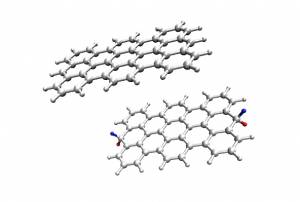Simple STM images
In this exercise we will consider different termination of two polyantryl molecules that are an intermediate step for the formation of a long armchair nanoribbon. 10.1021/ja311099k.
We will show how a simple change in the termination (1 vs. 2 Hydrogens) changes the state structure completely.
bsub -n 16.
Download, as usual, the files from the media manager: exercise_10.2.tar.gz. The 1h.1.5.inp file is commented).
1. Task: Running the job and looking at the orbitals
This time we will not optimize the structure. With an ENERGY run, we run with cp2k the job 1h.1.5.inp and 2h.1.5.inp, meaning that there are here 1.5 units of the original molecule in the gas phase.
The interesting part of the code is in the &PRINT section of &DFT :
&PRINT
! controls the printing of cubes for the generation of STM images.
&STM
! set of sample bias
! negative for occupied states and positive for unoccupied states
BIAS -2.0 -1.0 1.0 2.0
! orbital symmetry of the tip
! The change in the tip symmetry can radically alter the contrast of the topographic
! image due to changes in tip-surface overlap
TH_TORB S
&END STM
! print molecular orbitals
&MO_CUBES
! 10 occupied orbitals
NHOMO 10
! 10 unoccupied orbitals
NLUMO 10
! limit the size of cube files
STRIDE 2 2 2
WRITE_CUBE T
&END
! a cube file with eletrostatic potential generated by the total density (electrons+ions).
&V_HARTREE_CUBE
&END
&MO
! molecular orbitals eigenvalues and molecular ocuupations after each scf
FILENAME EIG
! add the last iteration with description
ADD_LAST NUMERIC
! printing of eigenvalues of molecular orbitals
EIGENVALUES
! also print occupation of the molecular orbitals
OCCUPATION_NUMBERS
&END
&END
There will be an output file with the energy levels and their occupation. The last one can be easily found…
- Draw the energy level diagram for the two molecules. What is the energy gap in the two cases? What are the differences?
- Look with vmd at the cube files corresponding to the most interesting levels (close to Fermi…). Comment on the distribution of the states.
2. Task: Producing a simple STM image
The section &STM shown above produces STM images at different bias (feel free to change), meaning, using the Tersoff-Hamann approximation, it integrates all the density of states with energies between Fermi energy and the Bias potential: this energy interval is involved in the tunnel current. The *STM*cube files are 3D maps of the integrated density of states. Imagine that we have a microscope with a feedback that can keep constant current between tip and sample, by changing the height of the tip on the surface. Since the current is proportional to the density of states, we move the tip on isosurfaces of our cubefile. The program stm ** (in the same working dir) allows to extract a 2D map of the height of a given isosurface.
Run the program in the following way: $ module load boost/1.54.0 $ module load mkl $ stm -c 2h*STM*.cube --isovalues 1E-5 > stm.out
The resulting .igor files contain the z profile (in bohr) and may for example be plotted by gnuplot:
gnuplot set pm3d map set size square set xrange [...... set yrange [..... splot "mystm.igor" matrix using 2:1:3
Where instead of “mystm” you use an appropriate filename.
- In the output file of cp2k, the program tells you how many states have contributed to each STM image. Discuss the images that you see in the two cases.
- What makes the 1h* case particular with respect to the 2h*?
- Change the isosurface and look at the z-range. Discuss the changes in the range.
- Would you define the differences between 1h and 2h in the STM images as more of structural origin or electronic origin?

